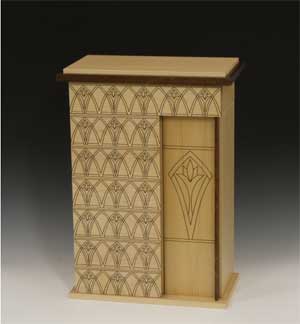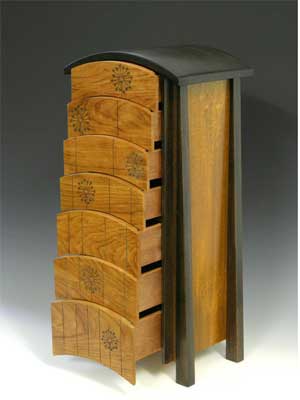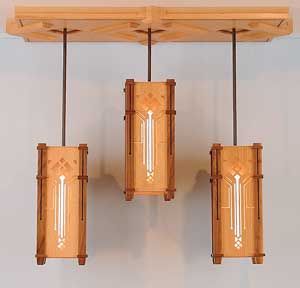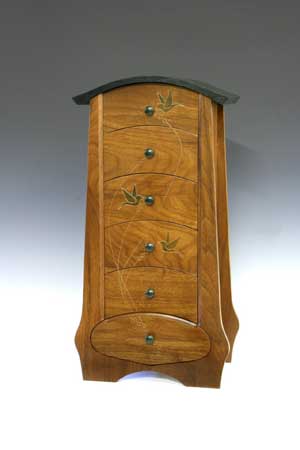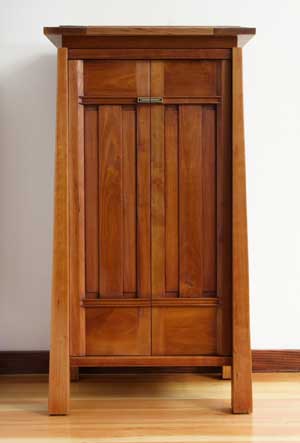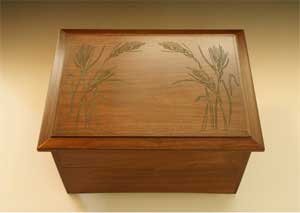
Over three decades ago, Alice Suszynski was trying to figure out what she wanted to do with her life. These days, she’s taking it in a different direction. Both stages, however, have involved woodworking.
When she was starting out as an adult, Alice hadn’t gone to college, yet “I knew I wanted a career of some kind. I spent a couple of years doing office work, and I thought, ‘I better figure this out.'” Thinking back to what she liked to do in her childhood, Alice realized that, “What I liked to do was make stuff. Neither of my parents was very handy, but I remembered my friends and I would go to vacant lots and build forts, and the bliss kids get.”
At first, her idea of “making stuff” prompted her to think “carpenter” as a career option, “but my uncle was an architect, and he said, ‘I think what you’re talking about is cabinetmaking.”
That uncle, however, also knew about an apprenticeship program available through the United Brotherhood of Carpenters. Alice was accepted into the organization as an apprentice in 1975, the first woman. “It was pretty revolutionary,” she said.
She did her apprenticeship at a large architectural casework shop near Chicago which did high-end commercial jobs. “I remember they were doing a job for the shah of Iran,” she said. “It was the 1970s, so there was a lot of German automated equipment coming in, and then you had guys on the bench with chisels and planes, using Old World stuff, at the same time.”
While she’s appreciative of such skills, as Alice developed her own woodworking career – later moving to Oregon to open a shop with her then-husband — she gravitated more toward doing her woodworking with power tools. “I think I once said something smart-alecky like, ‘If it can’t be done with a machine, I don’t want to do it.'” For instance, with hand-cut dovetails, “I’m not that fast,” she said. “It has to be really important for me to do it.”
She spent many years doing both commercial and residential custom jobs, built-ins and furniture, with one of her proudest moments coming from a wooden chandelier that won Best in Show at the San Diego Fine Woodworkers Association Design in Wood show in 2003. “I was playing around with cutouts, trying to figure out how to use cutouts, and that just came to me,” Alice said. Built from quartersawn white oak and walnut, the chandelier exemplifies a “really nice idea of cutting wood out and letting light shine through,” Alice said.
“I wish I could be doing more of that,” but lighting products have a great deal of regulation surrounding them, due to fire risk, Alice said.
Instead, she has taken a different approach to her latest journey in woodworking. “I’m in my later years, and I’m tired of hauling big things around,” she said. “It’s very stressful: damage can be done by the wrong move.”
While she is still doing custom cabinets and loves doing so, “I wanted to concentrate on smaller things,” Alice said. She and her husband, Ed, are currently doing limited edition jewelry boxes — Alice makes them and, soon, she plans to launch an option to sell kits for others to build them as well.
Alice’s jewelry boxes are created in the Arts and Crafts style, which has likely inspired her work for longer than she realized. She didn’t begin designing furniture, she said, until the early 1990s, when she took a class from Wendy Maruyama in the Woodworking and Furniture Design department at San Diego State University. “I was so excited just to get to be around her,” Alic said. “First of all, a woman [woodworker]; second, she was part of this really important movement, the studio art movement.
“Part of the course was to design a piece of furniture and then explain it. I had built desks and stuff, but I’d never really thought about design, what I wanted to say. When I hit upon Arts and Crafts, I thought, ‘that’s my thing’ — probably because I grew up in Chicago, and my heart is Arts and Crafts, Prairie.” (For instance, Alice noted that she felt an affinity with notable Prairie style architect Frank Lloyd Wright, a Wisconsin native, after learning that he, too, had liked to play with blocks.)
In many of her pieces, Alice said, “I use a lot of the lines found in the Arts and Crafts style. The crown on the top of a piece might extend past the next piece a little bit — very stepped. I like using shadows and light, and proportion: I love big overhangs on stuff; I think it gives a more grounded feel when the top overhangs.”
Alice said, “My favorite piece of anything I’ve ever made is my jewelry armoire. It’s all Arts and Crafts, Asian aesthetic. If I had to do it over, I would not change a thing.”
